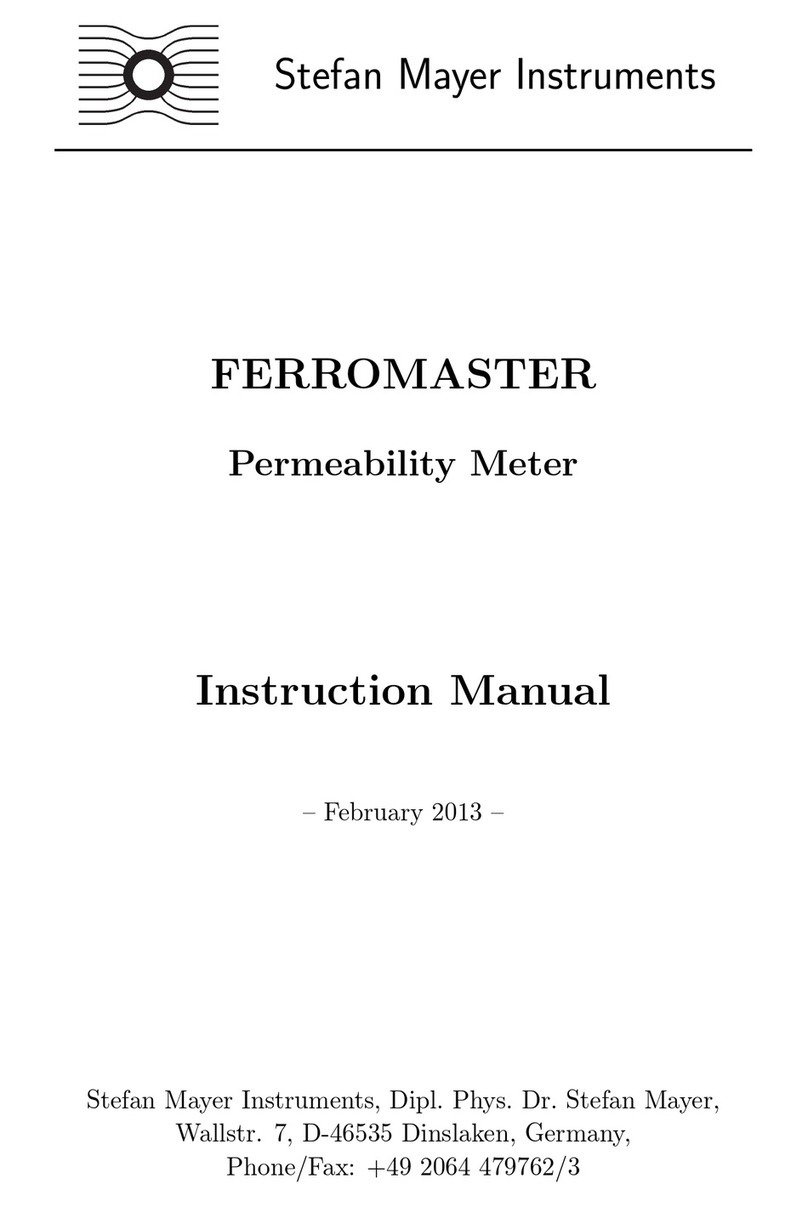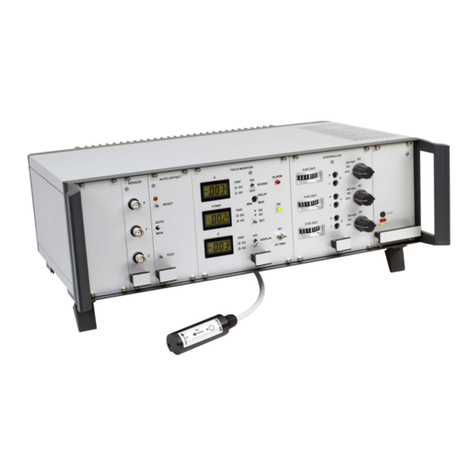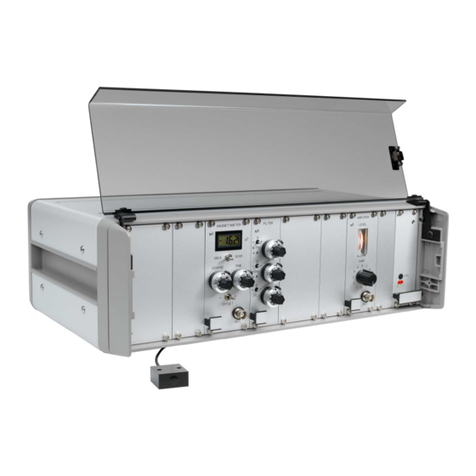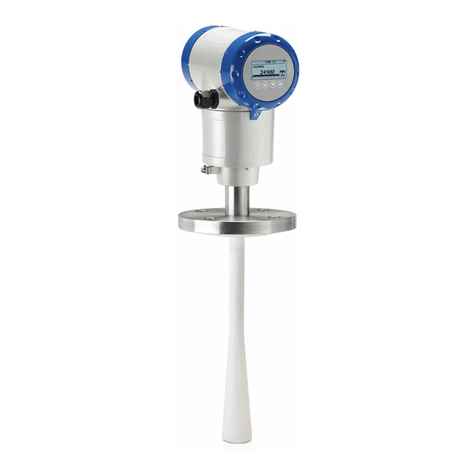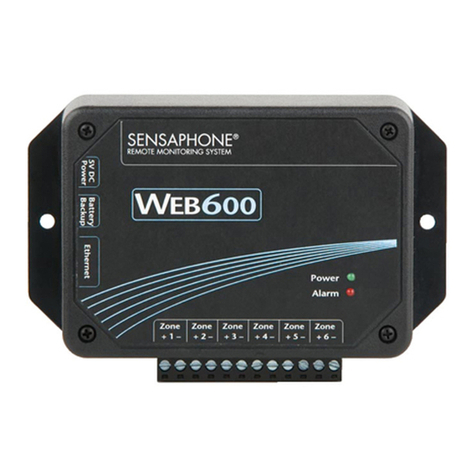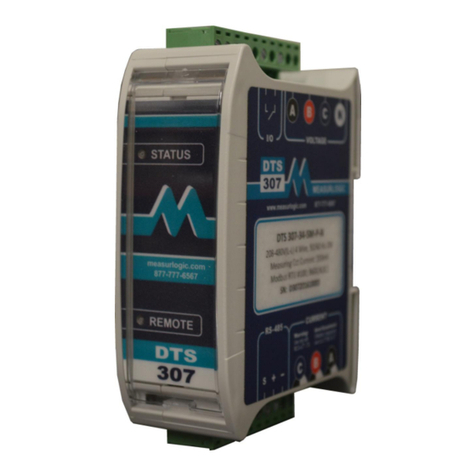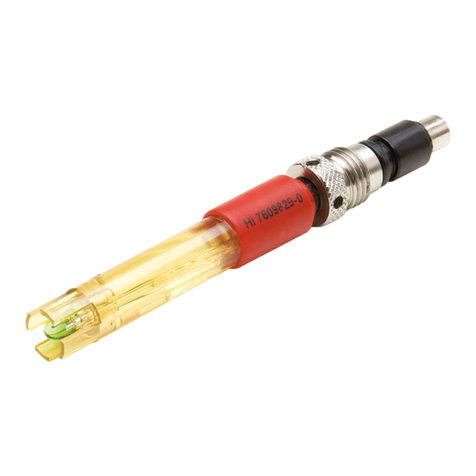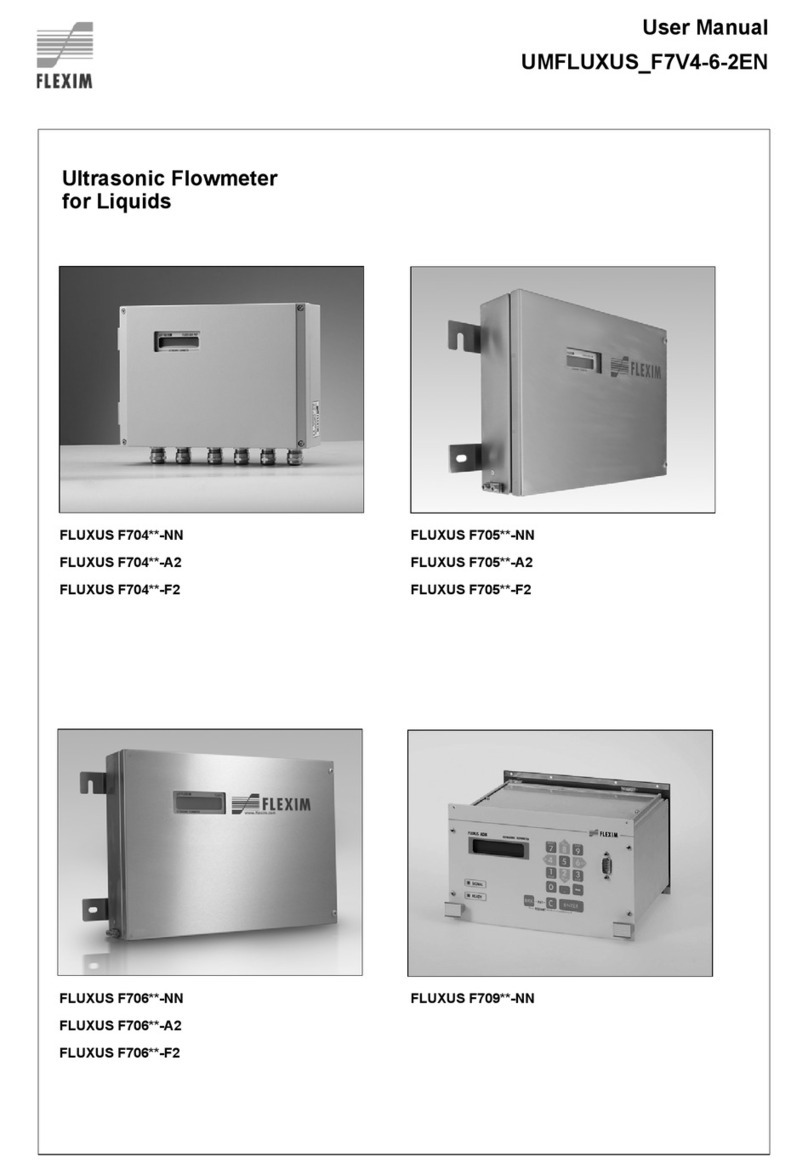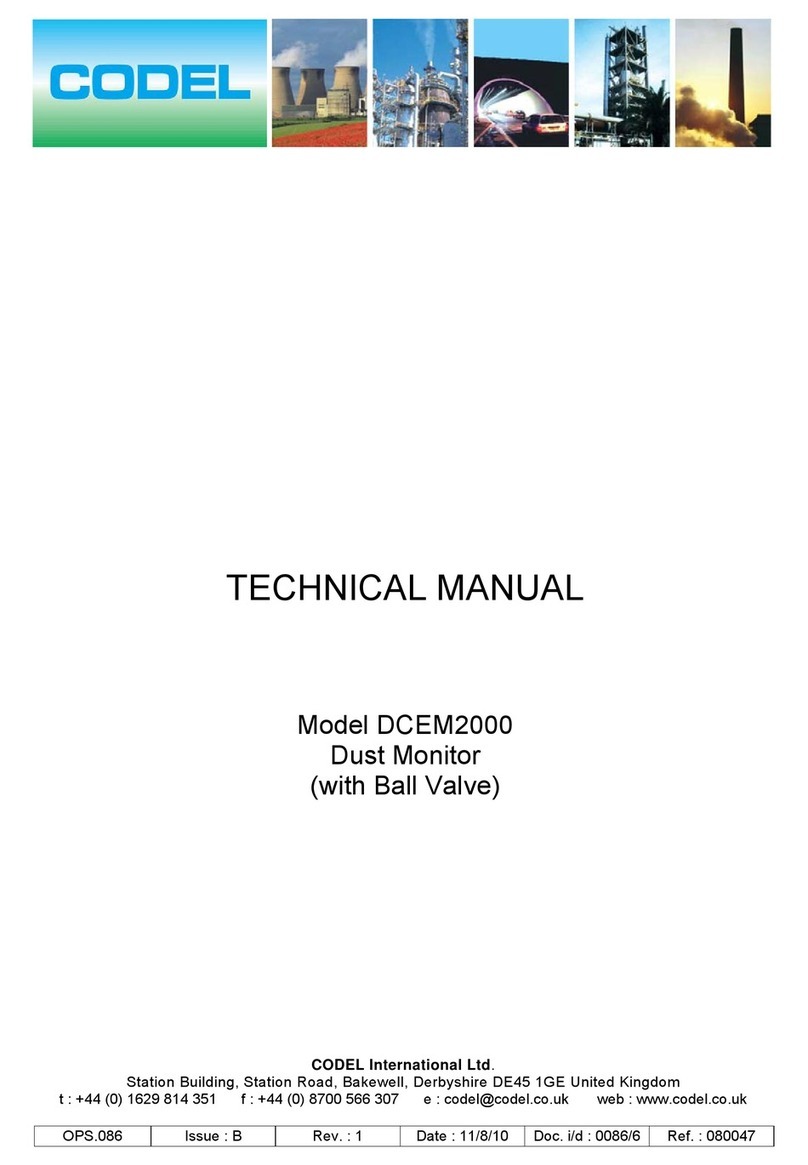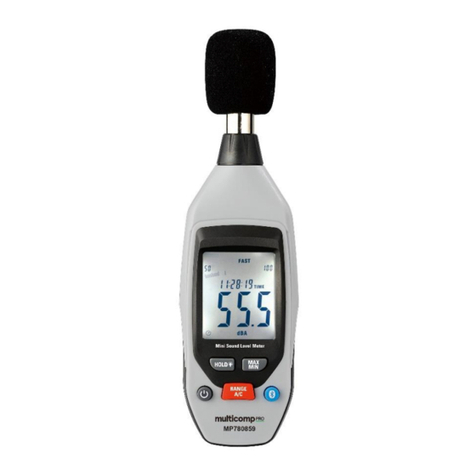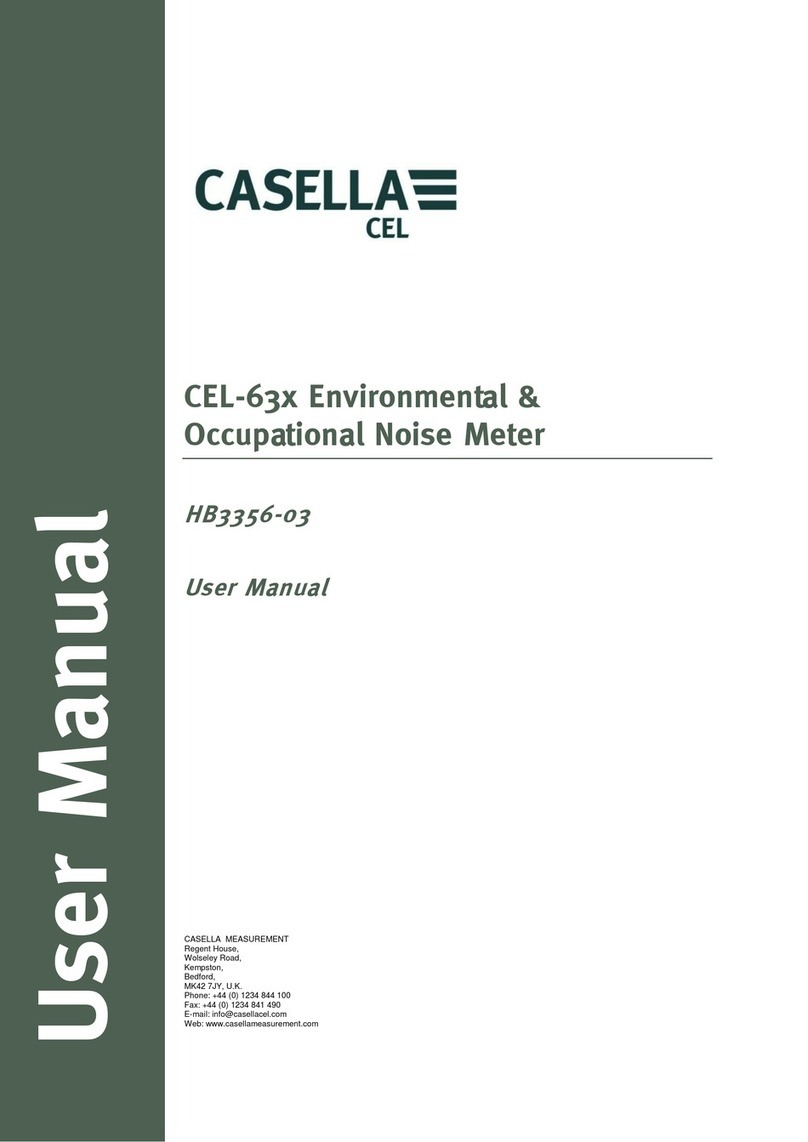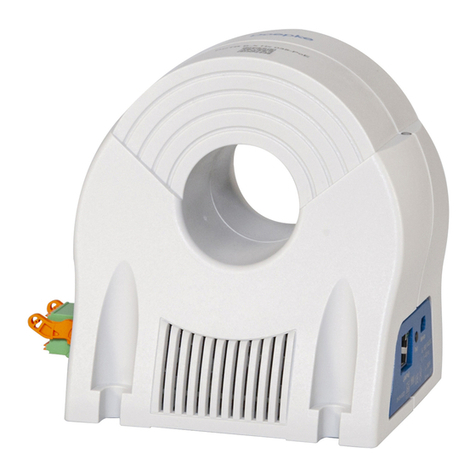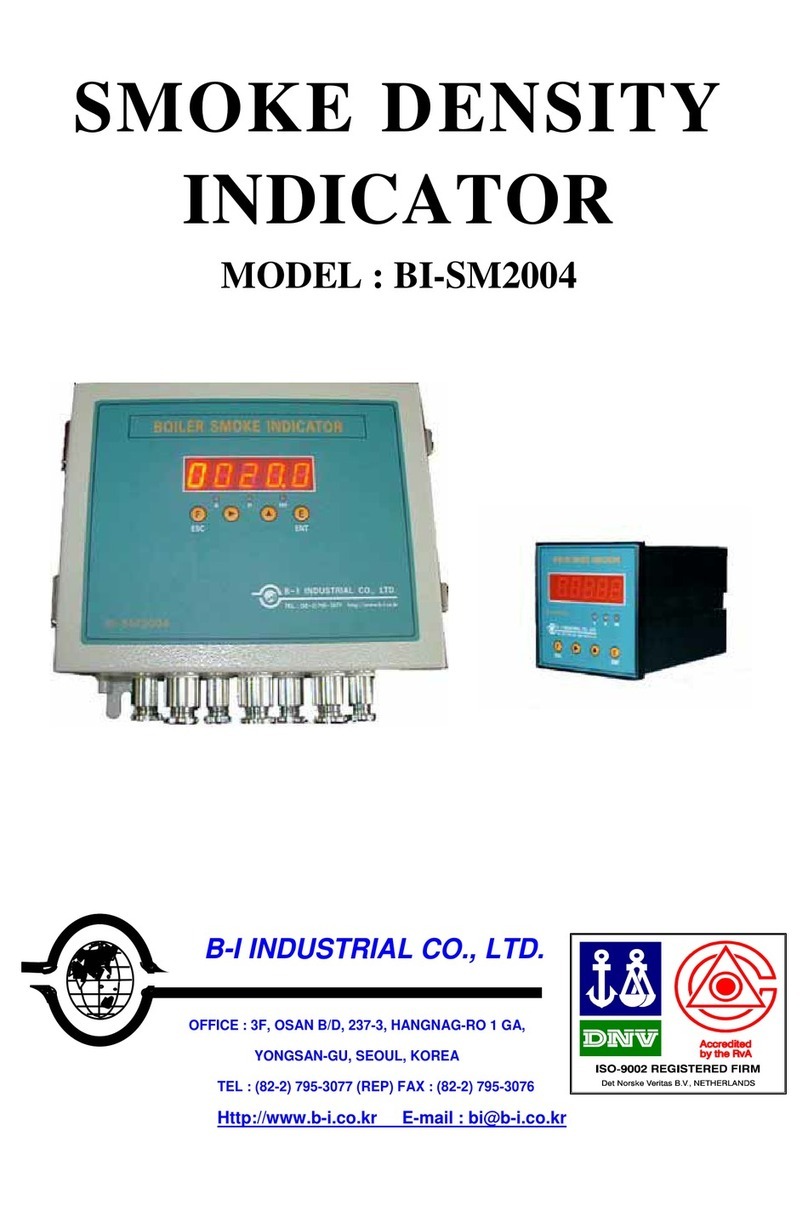Stefan Mayer Instruments AM502 Series User manual

AM502 Series
Proton Precession Magnetometer
Engineered by Alexander Mumm
www.alexmumm.de
Instruction Manual
July 2018
Document Version 4.1
Software Version V0406-0925
Stefan Mayer Instruments GmbH & Co. KG
Wallstr. 7, D-46535 Dinslaken, Germany,
Phone/Fax: +49 2064 479762/3
www.stefan-mayer.com

2
Contents
1 Safety Precautions ....................................................................................................... 3
2 Overview........................................................................................................................4
3 First Usage....................................................................................................................5
3.1 Sensor filling and preparation .............................................................................................. 5
3.2 Electrical Connections ......................................................................................................... 6
3.3 Power-On and Self-Test....................................................................................................... 6
3.4 Power-On with optional GPS-Receiver ................................................................................ 7
4 User Interface Concept ................................................................................................7
4.1 Push Buttons and Display.................................................................................................... 7
4.2 Measurement Display.......................................................................................................... 8
4.3 Key Functions in the Measurement View............................................................................. 9
4.4 Display of the Power Supply Status and of Exceptions........................................................ 9
4.5 Menu Structure.................................................................................................................. 10
5 Functions and Configuration..................................................................................... 11
5.1 LOGGING (Data Saving for Computer-Analysis) ............................................................... 11
5.2 TUNING (Bandpass Center Frequency)............................................................................. 12
5.3 PERIOD (Duration between Measurements)...................................................................... 12
5.4 DISPLAY (View Configuration)........................................................................................... 13
5.5 SOUND (Beeper Configuration)......................................................................................... 14
5.6 ALARM (Alarm Thresholds)............................................................................................... 14
5.7 AUTOTUNE (Automatic Tuning)........................................................................................ 15
5.8 GPS Info Display ............................................................................................................... 15
5.9 Software Version and Operating Voltage........................................................................... 15
6 Technical Specifications............................................................................................ 16
7 Digital Interface........................................................................................................... 16
7.1 Data Format....................................................................................................................... 16
8 Warranty...................................................................................................................... 17

3
1 Safety Precautions
The following safety precautions should be observed carefully before using this
instrument:
This product is intended for use by qualified personnel who are familiar with the safety
precautions required to avoid possible injury.
Read this instruction manual carefully before using the instrument!
The instrument must not be operated in explosive atmosphere.
The operation of the instrument is left at user's risk.
The sensor should not be placed in direct sunlight, especially at air temperatures above
30°C. This is especially relevant for stationary and continuous operation.
Never expose the sensor to air temperatures above 40°C!
Do not dip the sensor in water or any other electrical conducting and/or flammable liquids!
Do not connect the instrument to the 12V clamps of a car!
Never connect the instrument to voltages above 18V!
Avoid discharging Lead-Acid-Batteries below 11.5V!
Lead-Acid-Batteries must not stand upside down.
Wear eye protection glasses and gloves when filling the sensor with liquid!
Avoid disconnecting the sensor cable from the instrument whenever the magnetometer
operation is in progress!
Do not exceed the electrical and thermal operating limits, as defined in the specifications
section! Disregard can cause destruction of the instrument and consequential damages.
If the instrument is used in a manner not specified by the manufacturer, the protection
provided by the instrument can be impaired.
Stefan Mayer Instruments shall not be liable for any direct, indirect, special, incidental or
consequential damages arising out of the use of its instruments.
The instrument and this manual may be subject to alterations without prior notice.

4
2 Overview
The AM502 is a pulsed proton precession magnetometer that can be used for stationary as well as
for mobile measurement of the earth's magnetic field. An optional, external GPS receiver can be
connected. It allows the recording of measurement data together with geographic coordinates,
including date and time.
Electric coils are used to create a relatively strong magnetic field in the range of some millitesla to
polarize the proton spins in a liquid medium. This process can only be explained by means of
quantum-mechanics,which is not subject of this manual. After the polarization field has been
switched off the polarized spins precess about the vector of the external magnetic field, inducing a
measurable voltage signal into the coils that oscillates with the precession frequency. This signal
decays quickly within seconds because of two main reasons: first the polarization disappears due
to interaction mechanisms,and second because inevitable magnetic field gradients will result in
more and more phase shifts from different sections in the liquid medium, finally cancelling each
other.
A complete measurement cycle of the magnetometer comprises a polarization phase (e.g. half a
second) and ameasurement phase where the frequencyof the spin precession signal is determined
(e.g. 500 periods of a 2 kHz-signal). The precession frequency of the protons depends only on the
strength of the ambient magnetic field and is practically insensitive to temperature. Hence, very
high accuracy and resolution down to fractions of a nanotesla can be achieved. However, two
disadvantages cannot be neglected: the relatively low measuring rate, and the high electrical power
needed to generate the polarization field.
A proton magnetometer is a precision instrument, which cannot be used in the presence of magnetic
disturbances. This usually prevents the use nearby or within buildings. Power lines, pipes in the
ground, electric fences etc. will also usually render the measurements unusable. First experiments
should be carried out at least 20m away from buildings outside in the field. Ensure that no
ferromagnetic object is close to the sensor. No coins, no mobile phone (the speaker and vibration
motor usually will contain magnets), no pocket-knifes etc. should be carried when operating the
instrument. Moreover, keep the sensor as far as possible away from the control unit, from the power
source and from the GPS receiver!
A 12V lead-acid battery with a capacity of 5Ah or more is recommended as a clean power source
that will last for several hours of measurements.
Attention: The sensor is filled with flammable liquid, and the magnet coils can produce up to 20
Watts of thermal power. It is obvious that the sensor must not be overheated. The design is very
robust, but continuous stress with too high temperatures must be avoided. Especially at air
temperatures above 30 °C the sensor should not be placed in direct sunlight to avoid additional
heating due to sunlight absorption. This is usually relevant for stationary and continuous operation
only.

5
3 First Usage
3.1 Sensor filling and preparation
The sensor is shipped with empty inner volume, so the filling of the proton liquid is subject to the
end user. We recommend to use isopropanol or liquid paraffin, and to wear gloves and protective
glasses during the filling.
First of all, place the sensor upright on an even surface, with the cable outlet and the black locking
screw pointing upwards. Then open thesensor volume by looseningfirstly the small securing screw,
and then the locking screw. Insert a funnel into the sensor opening and begin to pour the liquid
carefully. The sensor must be filled up to the point where the diameter of the inner volume shrinks
down for the first time, please see the following figure.
When filling is completed, the locking screw must be tightened sufficiently, such that the o-ring can
seal the inner volume. Finally, tighten the securing screw.
After preparation, the sensor should be placed outside in free space at least 50 cm above the
ground to avoid field gradients caused by minerals, stones etc. A plastic or wooden stand can be
used for this purpose. Ensure that no nails or other metals are used within such a stand. The axis
of the sensor should be aligned such that the earth’s magnetic field lines are passing through the
sensor in a perpendicular way. This will result in a maximum precession signal from the protons.
Of course, the first power-on can also be done within a building. However, in this case only the
general usage of the menus, the display etc. can be tried out. The measurements will probably
make no sense. Optionally, the connection to a PC can be tested. This connection can be used to
receive actual measurement values, to download saved data or to update the firmware of the
instrument. A stabilized 12V power-supply is sufficient in this case if it can deliver at least 2A of
current. For stationary use of the magnetometer in an observatory a high-quality laboratory power
supply with a low ripple and without high-frequency components is mandatory. This type of usage
requires great care of the ground connections. These are usually the most common case if the
measurements are disturbed and jumping around.
FLUID LEVEL

6
3.2 Electrical Connections
The magnetometer has three main electrical interfaces at the front side of the control unit. These
comprise different pin configurations to avoid confusion.
12V Power Supply (Power, 3 Pins)
As already described, a clean 12V power source has to be connected here. The internal circuits
are optimized for lead-acid batteries, the usual voltage tolerances of such batteries are allowed.
Furthermore, the input is protected against reverse-voltage conditions. If reverse-voltages occur,
then the magnetometer will simply not operate.
Attention: Do not connect the instrument to the 12V clamp of a car! The voltage of automotive 12V
lines may increase far beyond 12V, and extreme spikes in the range of 100V can occur due to load
dumps of inductive systems in the vehicle! This can abruptly destroy the magnetometer.
Never connect the instrument to voltages above 18V. The circuits are not designed for high voltages
like that, and the power dissipation of the sensor would increase above the limits.
Sensor Connection (Sensor, 4 Pins)
The second essential connection goes to the magnetometer sensor. On the side of the control unit,
this connection includes the cable shield and the two poles of the sensor. On the sensor side only
the two poles are connected. The shielded sensor cable is audio-qualified with low microphonic
effect to reduce signal distortions.
Attention: Avoid disconnecting the sensor cable whenever the magnetometer operation is in
progress!
RS232 Data Interface with auxiliary 5V Supply (Data GPS, 5 pins)
This connection includes the Rx and Tx pins of a standard serial RS232 interface, as well as an
output voltage of 5V/100mA for the optional GPS receiver on a third pin. When connected to a
computer, then only the serial lines are used for data transfer. When the GPS receiver is connected,
then the magnetometer detects the NMEA data stream and uses it for augmenting stored
measurement data with coordinates, date and time in UTC format.
3.3 Power-On and Self-Test
When the power supply and the sensor have been connected the instrument can be turned on.
After that the internal initialization and system tests are performed in several steps:
If the sensor is correctly connected and if the supply voltage is in the allowed range, the
measurement display is shown after a few seconds, first without any valid data:
If error messages appear, then the problem has to be solved. Note that strong AC magnetic fields
(transformers, power-lines) or large iron objects directly besides the sensor can also result in a
failing self-test. This applies especially if the instrument is turned on within a building. If the self-test
fails, power has to be switched off and on again to repeat the initialization phase.
SYSTEM INIT...
01
-----.-
................

7
If the measurement logging was activated during previous usage, the instrument will startup in
STOP-mode (otherwise it will immediately start to take measurements). This prevents writing of
unwanted or unintentional measurements to the internal Flash-memory.
Results are displayed immediately after a measurement was taken. There are various display
modes that are explained later. One example is shown here:
If the message "TUNING?" appears, the measured value deviates significantly from the field tuning
parameter set in the corresponding configuration menu of the instrument (the setting of the tuning
is explained later in chapter 5.2). If the "TUNING?" message continuesto appear, even sporadically,
then there are usually strong disturbances present (power-lines, gradients, etc.).
3.4 Power-On with optional GPS-Receiver
The device constantly monitors the serial data reception line. If NMEA records in the expected
format are detected, it will assume that a GPS-receiver is connected. In this case it blocks any
further operation and waits until the GPS receiver has synchronized itself with the satellites,
providing correct coordinates as well as time and date. This can take many minutes, especially if
the GPS receiver was not powered on for a long time or if it was moved to another location far
away. When waiting for a GPS-fix, the magnetometer displays the “GPS-WAIT”message:
The numbers are showing some first data from the GPS receiver to indicate progress. When the
GPS-fix has been performed, a note will be displayed for a short time. It can be acknowledged with
the (OK) key, then it will disappear immediately.
4 User Interface Concept
4.1 Push Buttons and Display
The instrument settings can be accessed via three keys: (+), (–) and (OK). The (+) and (–) keys are
mainly used to change what is shown on the display. Pressing the (+) key for example moves from
the normal measurement result view to the view that shows information about the logging settings:
Pressing (+) or (–) againand again will cycle through all available views (see 4.5), while the settings
will not be changed. The settings itself can be accessed and modified when pressing (OK) in the
selected view. After that the (+) and (–) keys can be used to increment/decrement the parameter.
Pressing (OK) again will save the new setting:
GPS-WAIT 99.9
123055 080813
GPS SIGNAL OK
47521.3 nT
127/074
(+)
(-)
LOGGING
OFF FREE: 32768
(more views)
...
(+)
(-)
47521.3 nT
141/102

8
Some views do not offer an edit mode (for example when the software version is shown). In some
other views the (OK) key will start an immediate action (for example triggering the autotuning). Few
situations require a longer pressing of a key. However, everything will be explained in this manual
later.
4.2 Measurement Display
The various display options are explained in the following paragraphs.
Display Variant 1 –Magnetic Field Strength and Signal Quality
Besides the value of the magnetic field strength, an indication about the logging activity will be
displayed in the upper right corner (LOG=Logging without GPS; G-LOG=Logging with GPS):
In the lower right corner, the signal strength of the precession signal is displayed. The first number
shows the signal strength directly after the polarization phase, while the second number indicates
the strength after completion of the frequency measurement. These numbers are unit-lessguidance
values to see if the measurements are reliable or disturbed. They can be compared only if the tuning
setting is not changed.
Display Variant 2 –Bar Graph
This view shows a simple bar graph visualizing either the difference to a reference value (will be
set by a 3 sec. long press of the (OK) key, see below) or the difference to the previous
measurement. The lower right corner shows the numerical difference, respectively.
In the upper right corner, the logging indicator will be shown, as mentioned above. If no logging is
active, the first signal amplitude value (the one directly after the polarization) will be shown.
If the value range of the selected bar graph (see below) is exceeded, the symbols "<" or ">" will be
shown. The value in the lower right corner will still show the correct difference.
TUNING
47500 nT
(OK)
47500 nT
< - + >
(OK)
(+) Increment the Value (for example to 47750)
(-) Decrement the Value (for example to 47250)
Display-Mode
Edit-Mode
47965.0 nT G-LOG
071/056
47521.3 nT G-LOG
====== -12.3

9
4.3 Key Functions in the Measurement View
Start/Stop
By pressing (OK) shortly, the periodic measurements will be stopped or started. If the periodic
measurements are deactivated, the "STOP" message is shown in the upper right corner:
If the period time (see chapter 5.3) is set to "INFINITE", pressing the (OK) key will trigger a single
measurement.
Setting the Reference Value
A longer press (3 seconds) of the (OK) key will use the last measured value as a reference for the
bar graph difference display and for the alarm function (see chapter 5.6), if configured accordingly.
4.4 Display of the Power Supply Status and of Exceptions
If the power supply voltage is too high or too low, a message will be displayed. In this case it is not
possible to take measurements. Note that the internally measured supply voltage is shown in the
information display (see 5.9), too.
More messages (e.g. about the connectivity to a GPS receiver) will be displayed as needed.
Depending on the individual importance, the messages will be shown just shortly or they have to
be acknowledged with the (OK) key. Essential messages (for example a low-voltage condition) will
stay present constantly.
48142.1 nT STOP
===== -10.0

10
4.5 Menu Structure
TUNING
47500 nT
47965.0 nT
071/056
LOGGING
OFF FREE: 32768
PERIOD
1 s
DISPLAY
SIGNAL LEVELS
SOUND
OFF
ALARM
OFF
AUTOTUNE...
GPS
--//--
AM502 12.6V
V0401-0870
47965.0 nT STOP
071/056
REF SET
(OK)
(OK)
(OK 3s)
(Select)
(Edit)
(Edit)
(Edit)
(Edit)
(Edit)
(Trigger)
(OK)
(OK)
(OK)
(OK)
(OK)
(OK)
(OK)
(+) (–)
(+) (–)
(+) (–)
(+) (–)
(+) (–)
(+) (–)
(+) (–)
(+) (–)
(+) (–)
(+) (–)
(+) (–)

11
5 Functions and Configuration
5.1 LOGGING (Data Saving for Computer-Analysis)
In this menu the actual logging mode (ON/OFF) and the number of free entries will be shown:
By pressing (OK) a sub-menu with the following points is displayed:
Activate Logging
When pressing (OK) the storage of measurements in the internal flash memory will be activated.
To be sure about this logging activity, the "LOG" and "G-LOG" indicators should be observed when
taking measurements.
Deactivate Logging
Pressing (OK) in this menu will deactivate the logging.
Clear Logging Memory (Attention! All saved data will be lost!)
When pressing any other key than (OK), then nothing will be deleted. This offers a last chance to
leave this menu without any loss of data.
Back to the Main Menu
Pressing (OK) leaves the logging menu and returns to the main menu.
Hints regarding Data Logging
•An indication record will be saved when the periodic measurements are stopped (pressing (OK))
or started (pressing (OK) again). This allows to split sets of measurements (e.g. rows in a
surveyed field) during later computer analysis.
•It is not possible to view saved measurements via the display of the instrument, because a
practical navigation through a huge number of measurements with optional GPS data is not
realistic without spreadsheet tools as available on computers.
LOGGING
OFF FREE: 32768
LOG ON
< - + >
LOG OFF
< - + >
CANCEL
< + - >
CLEAR LOG (!)
< - + >

12
5.2 TUNING (Bandpass Center Frequency)
The magnetometer includes very sensitive amplifier stages because the precession signal is in the
range of a few microvolts. To allow a stable frequency measurement, the bandwidth of this signal
has to be reduced with band-pass filters. Therefore, it is required to know the approximate range of
the magnetic field to be measured:
As described in the concept of usage, this parameter can be modified by pressing (OK). After
choosing a tuning magnetic field the software will calculate the appropriate frequency for
programming the internal band-pass filters. It is possible to do this automatically, see chapter 5.7.
However, the easiest way to get an almost correct setting is to look up the earth's field strength on
a map as in the example shown below. When the first measurement is taken, the tuning can be
adjusted again to meet the exact value of the local field.
If the tuning is not within about 1000nT, the measurement values will fluctuate more and more in a
random way. If the deviation is too large the message "TUNING?" will be displayed. When
measuring the earth's magnetic field, it is not a problem at all to reduce the measurement range
because the field will usually never change so much that the initial tuning needs to be adapted.
5.3 PERIOD (Duration between Measurements)
The period time determines the time interval between the automatically triggered single
measurements. Note that the polarization time cannot be directly accessed. It will be automatically
selected according to the period time. For period times up to 10s the polarization time is half of the
period time, while for longer period times the polarization time will be always 5s.
TUNING
48000 nT

13
This is a reasonable limit, because longer polarization times will not significantly increase the
number of polarized protons anymore, and would be therefore a waste of electrical energy, causing
useless heat in the sensor, too.
If the polarization time will be increased more and more, the value "INFINITE" will show up at the
end. With this setting enabled, no automatic measurements will be taken. Instead, single
measurements can be triggered by pressing (OK). The polarization time is then fixed to 5s in order
to have maximum spin polarization.
5.4 DISPLAY (View Configuration)
The following six display variants are available. The particular setting determines what is shown in
the second row of the measurement display (see also section 4.2).
Signal-Amplitude Levels
The two dimensionless numerical values in the lower line, separated by a slash symbol, will indicate
the signal amplitudes on a range between 0 and 255 at the end of the polarization phase (first
number) and after the frequency measurement (second number). They allow an estimation of the
signal quality, which is usually influenced by the presence of interference fields and field gradients.
Bar Graph –Difference to a Reference ("R")
A simple bar-graph will be displayed. The left margin means –xx nT, the right one +xx nT (xx is
selectable in steps, for example 10, 20, 50 and so on). Also, the difference to a reference value will
be displayed, with the reference value being set by a long press of the (OK) key (see also chapter
3.3).
Bar Graph –Difference between last ("A") and actual ("B") Measurement
This is the same as the "===R===" setting, but the difference will be calculated between the
previous measurement and the actual measurement. The reference is not used in this case.
Disable backlight
The fourth setting is special and switches off the display backlight ("BACKLIGHT OFF"). If the
display is not required, this setting can be used to save energy.
PERIOD
1 s
SIGNAL LEVELS
< - + >
===R=== +-XX nT
< - + >
==A-B=== +-XX nT
< - + >

14
Longitude (only available with GPS receiver connected)
This variant shows the longitude measured by the GPS receiver. The aim is to enable the user to
follow a constant longitude.
Latitude (only available with GPS receiver connected)
The same as before, except that latitude is shown.
5.5 SOUND (Beeper Configuration)
This menu can be used to set the beeper volume and to determine if a beep is played after each
measurement:
The following settings are available:
OFF
The beeper is completely switched off (not recommended). No sounds
(even no alarms) will be played.
MIN
Low volume sounds will be played after each key press and in case of
an alarm (see 5.6).
MIN/MEAS
As above, but with additional beep after each measurement.
MED
Same as MIN but with medium volume.
MED/MEAS
Same as MIN/MEAS but with medium volume.
MAX
Same as MIN but with maximum volume.
MAX/MEAS
Same as MIN/MEAS but with maximum volume.
5.6 ALARM (Alarm Thresholds)
This menu enables to configure the acoustic alarms. An alarm tone will be played each time a
configured limit is exceeded.
The following settings are available:
OFF
Alarm feature disabled.
SOUND
MAX/MEAS
ALARM
OFF
GPS LON
< - + >
GPS LAT
< - + >

15
ALARM –R- >xxxnT
If the absolute difference to the reference measurement value (long
press (OK)) exceeds xxx the alarm will be triggered.
ALARM A-B >xxxnT
If the absolute difference between the last and the actual measurement
value exceeds xxx the alarm will be triggered.
Note: If the sound setting is OFF no alarms will be played.
5.7 AUTOTUNE (Automatic Tuning)
By pressing (OK) the automatic search for the optimal tuning setting will be started. It is essential
that the sensor resides in an undisturbed environment during the complete process. Also, the
maximum precession signal should be present. This is usually achieved when the sensor is aligned
such that the earth's magnetic field lines cross the sensor axis in a perpendicular way (see chapter
2.1). Note that the auto-tuning feature takes about 2 minutes.
After the optimal tuning value has been determined, it appears on the display, but is not
automatically used. The user can decide if it shall be taken (press (OK) key) or discarded (press
(+) or (–) key).
5.8 GPS Info Display
This display shows information gained from the GPS receiver.
It includes the GPS deviation of position in meters (upper right corner), as well as the UTC time and
date in the lower row. If no GPS receiver is connected, then the disconnected-symbol will be shown:
The GPS receiver can be connected to the magnetometer even after startup. It will then be
automatically detected.
5.9 Software Version and Operating Voltage
The software version (lower left corner) and the actual operating voltage (upper right corner) will be
displayed:
The operating voltage will be dynamically updated.
AUTOTUNE...
AM502 12.7V
V0301-0039
GPS-OK 1.2
123055 080818
GPS
--//--

16
6 Technical Specifications
Display resolution: 0.1 nT
Absolute accuracy: 2.0 nT
Sensitivity: 0.3 nT (at 1/s sampling rate)
Measuring range: 30,000 nT to 60,000 nT, other ranges on request
Sampling rate: 1/s to 1/min or manual triggering
Flash memory: 32768 measurements (including time/date and GPS coordinates)
Display: 2x16 characters LCD with bar-graph
Computer interface: RS-232, 19200 baud
Supply voltage range: 10 to 15 V
Current consumption: 0.8 A typically, 2.0 A maximum
Dimensions of control unit: 171 mm x 130 mm x 54 mm; weight: 0.6 kg
Dimensions of sensor: 75 mm (diam.) x 235 mm (without cable gland); weight: 1.7 kg without
liquid filling, 2.0 kg with liquid filling
Operating temperature: -20 to +40 °C
Length of sensor cable: 2 m
Weatherproof rating: IP65
7 Digital Interface
7.1 Data Format
The RS232 interface can be used either to connect a GPS receiver or to allow data transfer to a
computer. The included special software program ppmtool is required to copy saved data from the
magnetometer flash memory to the computer. However, no special software is required to get the
actual measurement results. They are sent over the interface in the following format:
01 481253 098 067CR
01 481254 070 042CR
01 481261 076 051CR
02 123456 123 123CR
03 123456 123 123CR
01 481261 076 051CR
The first number indicates the type of the record:
01
Normal measurement. The measurement result in nanotesla multiplied by 10 (to avoid
commas) follows. The two numbers at the end represent the information about the signal
amplitude as it is also shown on the display.
02
This record indicates that the periodic measurements have been started (usually by
pressing (OK)). The following numbers have no meaning.
03
This record indicates that the periodic measurements have been stopped (usually by
pressing (OK)). The following numbers have no meaning.
Note: Every line is terminated with a "newline"-character CR (Unix-format). A "carriage-return"
(Windows format) will not be transmitted.

17
8 Warranty
All components of the AM502 Proton-Precession Magnetometer are warranted to be free from
defects in material and workmanship for a period of two years from the date of delivery to the
purchaser. The warranty will apply only if the instrument is operated in accordance with this
instruction manual and if the instrument is not changed by the purchaser. This does not include any
refilling of the sensor with fluids which are approved by the manufacturer. In the case of any defect
please contact Stefan Mayer Instruments.
Serial number:
Begin of warranty:
End of warranty:
Date, signature:
Stefan Mayer Instruments GmbH & Co. KG
Wallstr. 7, D-46535 Dinslaken, Germany
Phone/Fax: +49 2064 479762/3
www.stefan-mayer.com
Table of contents
Other Stefan Mayer Instruments Measuring Instrument manuals
Popular Measuring Instrument manuals by other brands

Luster Leaf
Luster Leaf 1835 user manual
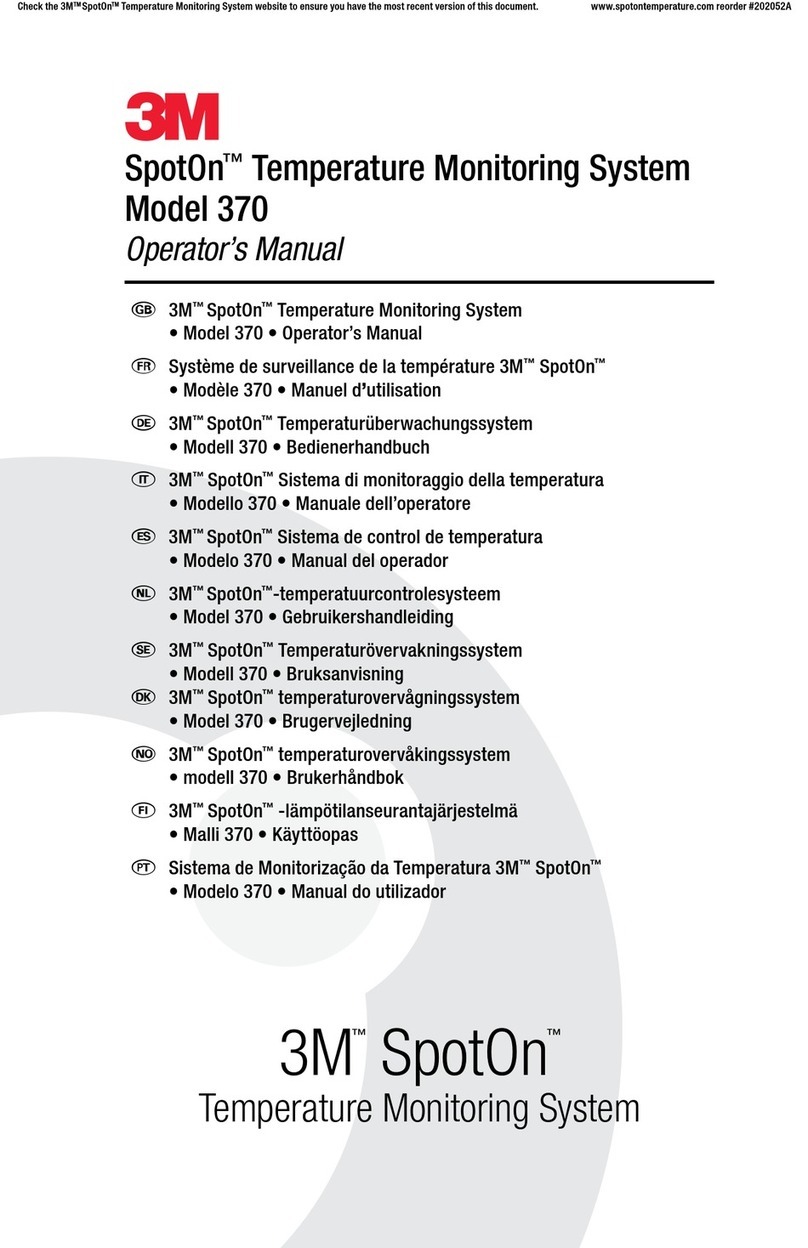
3M
3M SpotOn 370 Operator's manual
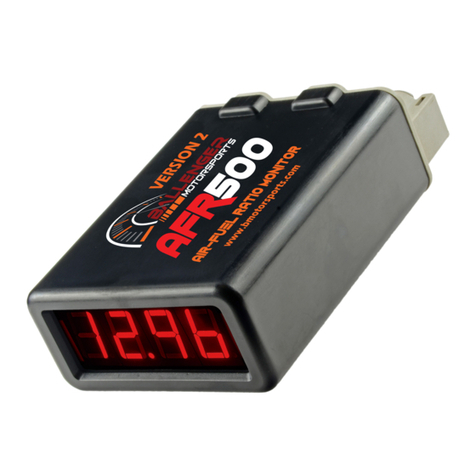
Ballenger Motorsports
Ballenger Motorsports AFR500v2 Tuning Manual

Pfeuffer
Pfeuffer 8 operating instructions
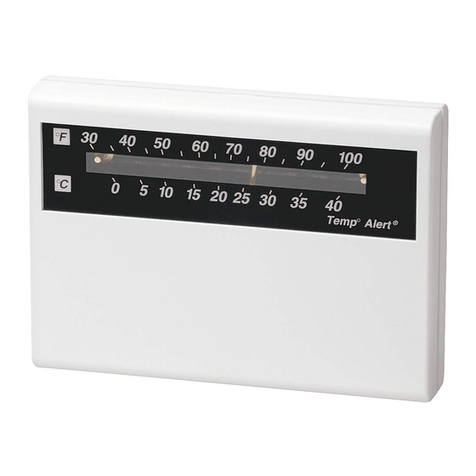
Winland Electronics
Winland Electronics TempAlert MTA-1 quick start guide

Critical Environment Technologies
Critical Environment Technologies FCS installation manual
